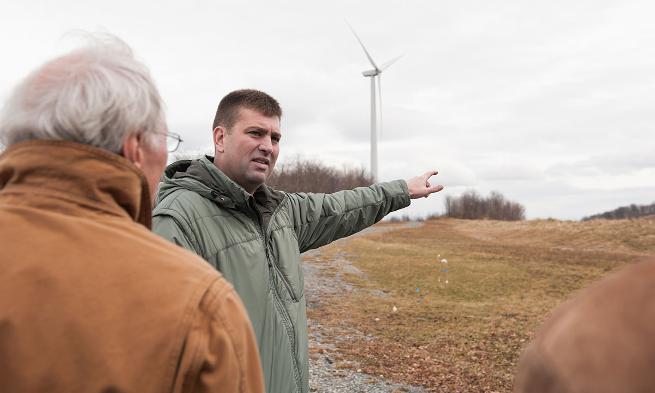2013 Virginia Center for Wind Energy update
Science and Technology
SUMMARY: Miles is working with officials in several southwest Virginia counties that have been approached by energy companies seeking to build wind farms. The state does not have any utility-scale wind farms, but Miles is hopeful that will change in the near future. If not along the state's western mountains, then somewhere off its coast, which has the state's best wind resources.
A little more than two hours west of Harrisonburg, on the mountain ridges of Greenbrier County, W. Va., wind turbines are churning out enough electricity to power about 30,000 homes a year.
The Beech Ridge wind farm, run by Invenergy LLC, has 67 turbines now and is looking to add 33 more. The technology is always changing, always improving to become more efficient, said Erik Duncan, a senior manager who oversees the project that began operating in August 2010. Duncan recently took a group of southwest Virginia officials on a tour of the facility so they could see it in operation and get a sense of how a wind farm might operate in their counties. The tour was arranged by Dr. Jonathan Miles, professor of integrated science and technology, and director of the Virginia Center for Wind Energy at JMU.
Miles is working with officials in several southwest Virginia counties that have been approached by energy companies seeking to build wind farms. The state does not have any utility-scale wind farms, but Miles is hopeful that will change in the near future. If not along the state's western mountains, then somewhere off its coast, which has the state's best wind resources.
Nationwide, the wind power industry has experienced rapid growth for several years. Since 2007, only natural gas has outpaced wind as a source for new electricity generating capacity. And while the country gets just 3 percent of its electricity from wind, the goal is to increase that percentage to 20 by 2030. That means there will be jobs in the wind industry and in other industries, such as manufacturing, that support it.
JMU's effort to support the wind industry has grown steadily in the 11 years Miles has been involved, starting with the organization of a wind working group, the Virginia Wind Energy Collaborative, in 2002. Today, the collaborative comes under the umbrella of the Virginia Center for Wind Energy, which has a staff of seven and is involved in a number of research, education and outreach endeavors. Just last year, the center opened the Small Wind Training and Testing Facility on the campus east of Interstate 81, adjacent to Rose Library. The small wind facility, which features a 7.5 kW turbine, a suite of meteorological instruments and has room to grow, will be used to train students on collecting data and other aspects of the wind industry, including turbine installation. The training facility also will be used to train wind installers.
The Virginia Center for Wind Energy also administers Virginia's Wind for Schools program. The federally-funded program works to raise awareness of the benefits of wind energy through 11 university wind application centers around the country. The centers work with public schools and communities to build wind turbines that increase student involvement in wind energy development and raise their awareness of wind energy benefits.
So far, four schools have added turbines in Virginia, including two this school year—Thomas Harrison Middle School in Harrisonburg and Central High School in Woodstock.
Another outreach program, the state-based anemometer loan program, supports landowners' interest in wind energy through the loan of anemometers and education about wind-energy development. Collected data allows landowners to assess the economic feasibility of using wind energy. JMU receives program assistance from the National Renewable Energy Laboratories and Virginia's Department of Mines, Minerals and Energy to select the best candidate sites, install towers and collect data.
With all that is happening in wind power, Miles sees opportunities to get more JMU disciplines involved in the training. So far, wind power education has primarily been offered to integrated science and technology students, but the groundwork is being laid for a possible interdisciplinary wind minor.
"We have the facilities and the resources and the capabilities," Miles said during a recent meeting with faculty from various parts of the university. "We want to make sure others on campus know about these resources."
Miles said an interdisciplinary approach also would expose the wind center to new opportunities.
